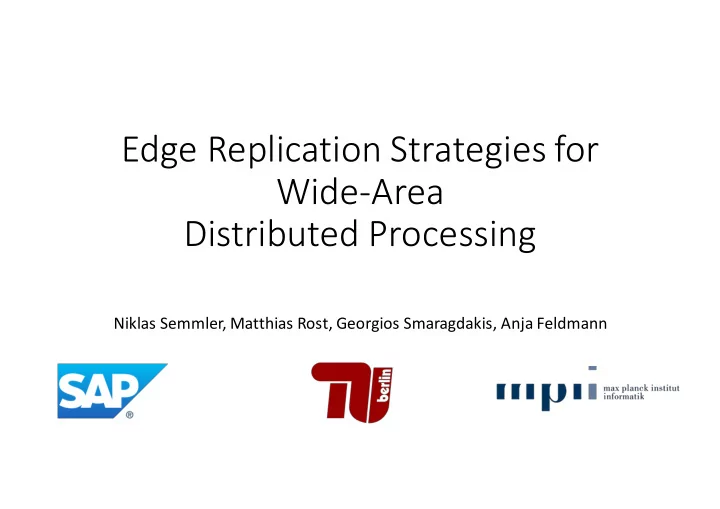

Edge Replication Strategies for Wide-Area Distributed Processing Niklas Semmler, Matthias Rost, Georgios Smaragdakis, Anja Feldmann
Generate Data Heavy processing & Content Distribution Local processing & Temp. storage Internet Edge World Datacenter Limited bandwidth & Pay for transfers How do we reduce the transfe ferred data volume? 2
Setting App Query Result Replication Edge World Datacenter Option B: Option A: Replicate raw data. Transfer query results. Cost Per-query-result Replication cost (cumulative) (one time) Many large Good for ... Few small non- overlapping results overlapping results 3
Problem ??? Past Future Now Fu Future demand is not known in advance! 4
Replication strategy Strategy determines when data is replicated given a record of its past accesses. Naïve Optimal Offline • Replicate immediately. • Replicate immediately, if future demand is larger than replication cost. • Replicate never. Data-dependent Requires knowledge of future Ca Can we do better? 5
Data Organization: Partition • Data is immutable. • e.g., machine logs • Data is partitioned. • Space: e.g., by machine, by location, etc. • A partition is accessible for a time window. • then removed or archived. 6
Dataset • Trace of an ERP database of a Global 2000 company. • Accesses at row-level. • Partition := 10k rows • Time window := 1 day Note: logarithmic color-scale! 7
>50% Cheap replication Costly replication potential Potential reduction reduction • Cumulative cost := • Sum of query result sizes sent over time window • Replication cost := • Partition size x replication cost factor Replication cost factor depends on compression, overhead, ... 8
Replication Strategies I. Competitive II. Heuristic • • Guaranteed worst-case performance. Exploit access traces. III. Hybrid • Combination of above. 9
Strategies: Competitive Ski-rental (Karlin et al.) Competitive Strategy • Use threshold to decide replication. A strategy that has a bounded worst- • If past transfer cost > replication cost: case performance in comparison to replicate! the optimal offline strategy. • 2-competitive algorithm. • Provably best worst-case bound. Wh Why do we need more than this? 10
Dataset Insights Similar activity Repeating Patterns > 50% partitions < 1% partitions have < 1k accesses have > 100k accesses Skewed distribution: Accessed partition is more likely to be Does popularity Do popular partitions accessed in the future than not. depend on exhibit patterns of Ski-rental does not use this! location? activity? 11
Strategies: Heuristics • Last-partition • Replicate if partition in previous time window exceeded replication cost. • Last-threshold • Compute best threshold over partitions in past time window. • Machine learning classifier (Random Forest) • Classify patterns into exceeding/not exceeding replication cost. • Replicate if accesses pattern match. 12
Strategies: Hybrid • Replicate if either Ski-rental OR Classifier replicate. • Configure ML to be conservative. • Goal: Replicate earlier than pure Ski rental → avoid transfers. 13
Replication Strategies I. Competitive II. Heuristic III. Hybrid • Ski-rental • Last-partition • Ski-rental OR Classifier • Classifier • Last-threshold VS Naïve Baseline Optimal Offline min(Replicate-all, Replicate-nothing) 14
Transfer Cost Reduction Worse than baseline Better than Insights Cheap Costly baseline 1. Ski-rental achieves 38% reduction replication replication on average. Up to 50% for some cases. 2. Last-partitionperforms poorly. 3. Last-threshold close to ski-rental. 4. Classifier worse than ski-rental. 5. Hybrid: Small improvement. 15
Transfer Cost Reduction Hybrid: Slight improvement in replication timing. 16
Conclusion • Introduced replication strategies. • Ski-rental reduces transfers by 22%/50% on average/best-case. Both traces • Hybrid strategy improves performance by 25%/51%. Ongoing work • Improve machine learning. • Include other cost factors (storage, etc.) Interested in the performance on your data? Please contact us: niklas.semmler@sap.com 17
Thank you! 18
Recommend
More recommend